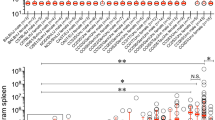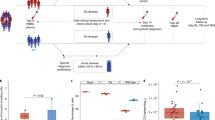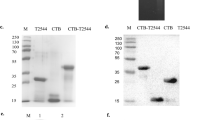Abstract
Salmonella enterica serovar Typhi is a pathogen that only infects humans. Currently, there is no animal model for studying this pathogen. Recently, alymphoid RAG-2−/−/γc−/− mice engrafted with human leukocytes, known as humanized mice, have been successfully utilized to develop experimental models for several human-specific viral infections, including HIV, human-like dengue fever and hepatitis C virus. Little is known about the usefulness and feasibility of the humanized mouse model for the study of human-specific bacterial pathogens, such as S. typhi. The aim of this study was to determine if Salmonella enterica serovar Typhi could establish productive infection in humanized mice. Here we report that intravenous inoculation of S. typhi into humanized mice, but not controls, established S. typhi infections. High bacterial loads were found in the liver, spleen, blood and bone marrow of mice reconstituted with human leukocytes, but not in the unreconstituted control mice. Importantly, S. typhi-infected humanized mice lost significant body weight, and some of the infected mice displayed neurological symptoms. Our data suggest, for the first time, that humanized mice are susceptible to S. typhi challenge and that this model can be utilized to study the pathogenesis of S. typhi to develop novel therapeutic strategies.
This is a preview of subscription content, access via your institution
Access options
Subscribe to this journal
Receive 12 digital issues and online access to articles
$119.00 per year
only $9.92 per issue
Buy this article
- Purchase on Springer Link
- Instant access to full article PDF
Prices may be subject to local taxes which are calculated during checkout


Similar content being viewed by others
References
Retamal P, Castillo-Ruiz M, Mora GC . Characterization of MgtC, a virulence factor of Salmonella enterica Serovar Typhi. PLoS One 2009; 4: e5551.
Pang T, Levine MM, Ivanoff B, Wain J, Finlay BB . Typhoid fever—important issues still remain. Trends Microbiol 1998; 6: 131–133.
Parry CM, Hien TT, Dougan G, White NJ, Farrar JJ . Typhoid fever. N Engl J Med 2002; 347: 1770–1782.
Lynch MF, Blanton EM, Bulens S, Polyak C, Vojdani J, Stevenson J et al. Typhoid fever in the United States, 1999–2006. JAMA 2009; 302: 859–865.
Matheson N, Kingsley RA, Sturgess K, Aliyu SH, Wain J, Dougan G et al. Ten years experience of Salmonella infections in Cambridge, UK. J Infect 2010; 60: 21–25.
Legrand N, Ploss A, Balling R, Becker PD, Borsotti C, Brezillon N et al. Humanized mice for modeling human infectious disease: challenges, progress, and outlook. Cell Host Microbe 2009; 6: 5–9.
Traggiai E, Chicha L, Mazzucchelli L, Bronz L, Piffaretti JC, Lanzavecchia A et al. Development of a human adaptive immune system in cord blood cell-transplanted mice. Science 2004; 304: 104–107.
Muchmore EA . Chimpanzee models for human disease and immunobiology. Immunol Rev 2001; 183: 86–93.
Baenziger S, Tussiwand R, Schlaepfer E, Mazzucchelli L, Heikenwalder M, Kurrer MO et al. Disseminated and sustained HIV infection in CD34+ cord blood cell-transplanted Rag2−/−gammac−/− mice. Proc Natl Acad Sci USA 2006; 103: 15951–15956.
Bente DA, Melkus MW, Garcia JV, Rico-Hesse R . Dengue fever in humanized NOD/SCID mice. J Virol 2005; 79: 13797–13799.
Mota J, Rico-Hesse R . Humanized mice show clinical signs of dengue fever according to infecting virus genotype. J Virol 2009; 83: 8638–8645.
Turrini P, Sasso R, Germoni S, Marcucci I, Celluci A, Di Marco A et al. Development of humanized mice for the study of hepatitis C virus infection. Transplant Proc 2006; 38: 1181–1184.
Kwant-Mitchell A, Ashkar AA, Rosenthal KL . Mucosal innate and adaptive immune responses against herpes simplex virus type 2 in a humanized mouse model. J Virol 2009; 83: 10664–10676.
Xu T, Maloy S, McGuire KL . Macrophages influence Salmonella host-specificity in vivo. Microb Pathog 2009; 47: 212–222.
Kwant-Mitchell A, Pek EA, Rosenthal KL, Ashkar AA . Development of functional human NK cells in an immunodeficient mouse model with the ability to provide protection against tumor challenge. PLoS One 2009; 4: e8379.
Scaramuzzino DA, McNiff JM, Bessen DE . Humanized in vivo model for streptococcal impetigo. Infect Immun 2000; 68: 2880–2887.
O'Brien AD . Innate resistance of mice to Salmonella typhi infection. Infect Immun 1982; 38: 948–952.
Karim M, Islam N . Salmonella meningitis: report of three cases in adults and literature review. Infection 2002; 30: 104–108.
Mittal S, Saxena A, Garg P . Unusual presentations of Salmonella Typhi infections in children. Trop Doct 2009; 39: 27–28.
Leung KY, Finlay BB . Intracellular replication is essential for the virulence of Salmonella typhimurium. Proc Natl Acad Sci USA 1991; 88: 11470–11474.
Acknowledgements
We are thankful to Dr Brain Coombes, McMaster University, Canada, for providing us with Salmonella typhi and for helpful discussions. This study was supported by a grant from CIHR to Ali A Ashkar. AAA is a recipient of a Career Award in Health Sciences from Rx&D/CIHR.
Author information
Authors and Affiliations
Corresponding author
Additional information
Note: Supplementary information is available on the Cellular & Molecular Immunology website.
Supplementary information
Rights and permissions
About this article
Cite this article
Firoz Mian, M., Pek, E., Chenoweth, M. et al. Humanized mice are susceptible to Salmonella typhi infection. Cell Mol Immunol 8, 83–87 (2011). https://doi.org/10.1038/cmi.2010.52
Received:
Revised:
Accepted:
Published:
Issue Date:
DOI: https://doi.org/10.1038/cmi.2010.52
Keywords
This article is cited by
-
Identification of collaborative cross mouse strains permissive to Salmonella enterica serovar Typhi infection
Scientific Reports (2023)
-
Humanized model mice by genome editing and engraftment technologies
Molecular & Cellular Toxicology (2018)
-
Frequency of Human CD45+ Target Cells is a Key Determinant of Intravaginal HIV-1 Infection in Humanized Mice
Scientific Reports (2017)
-
A germline-competent embryonic stem cell line from NOD.Cg-Prkdc scid Il2rg tm1Wjl /SzJ (NSG) mice
Transgenic Research (2013)



